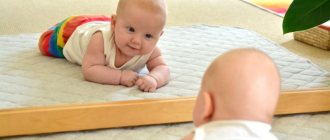When raising a baby, all parents are interested in the norms and timing according to which the child should develop. One of the most pressing questions for parents of a child who has reached the age of 5 months is the baby’s ability to occupy a vertical position. The age range is 6-8 months when the baby begins to sit.
The child is sitting
At what months does a child begin to sit and walk independently?
There is no clearly defined age limit when a baby should be able to sit up on his own. In most cases, this occurs between the eight and nine month period. Younger children (from five months to eight months) still need the opportunity to lean on mom or dad. And the baby usually begins to walk closer to the first year of life.
What time does a boy sit down?
To date, pediatricians have proven that the gender of the child does not in any way affect when he can start sitting down. Therefore, both the boy and the girl begin to sit up on their own from the six-month to nine-month period. This interval is determined by the individual development of each baby.
What time does a girl sit down?
Previously, it was believed that sitting down for a girl should begin much later than for a boy. This was due to negative consequences for her reproductive system. Today it has been proven that this is just a myth that has no relation to reality.
Differences in the development of boys and girls
When a child starts to gurgle and gurgle
Each child is individual. The degree and speed of his development are influenced by both the genes inherited from his parents and his personal abilities. One child can sit up at the age of six months, another at seven and a half months will only try to do this, constantly falling on his side.
Moreover, in addition to each child's individuality, there is a significant difference between boys and girls. We are not talking about obvious primary sexual characteristics. In children of different sexes, from the first days of life, significant differences can be noted in the timing of mastering many skills. The main factor is the developing brain. In boys and girls, it grows and improves at completely different times, which affects the following differences:
- Girls pronounce their first words earlier - already at the age of 1 year, while boys begin to master speech 2-3 months later;
- adaptation to a new society is easy for girls, they are sociable, even in infancy they get used to new relatives faster than boys;
- it is easier for girls to switch from one activity to another, from a doll to an animal, while boys hold their attention longer on one object or activity, switching their attention more slowly and without much desire to something new;
- girls' visual memory is focused on the details of the object, while boys' attention is concentrated on the very essence of what they see;
- The right half of the brain, which is largely responsible for the development of spatial skills, develops more slowly in girls than in boys, which explains the greater ability of men to navigate in space.
The same applies to physical development. Girls in infancy seem to be in a hurry to improve. They sit down first, then get up and take their first steps. However, the child’s environment has a significant influence. If a baby is constantly held in his arms, without giving him the opportunity to independently feel himself in space, such a child does not have the opportunity to master motor function.
Learns to crawl
Important! Children who are often placed on their stomachs are allowed to play with toys, try to crawl, and develop stronger back muscles earlier than others. In this regard, the age when such a child sits down comes faster.
How to understand that the child will sit down soon?
A sign that the baby will try to sit up is a straight back when standing upright. This is an indicator of his readiness to sit down.
To understand that the child is ready to sit down, pediatricians check the condition of the back muscles: you need to hold the baby vertically by the legs and hold the chest with your hand.
If a child begins to fall to the side or backwards, his shoulders droop - this is a sign of insufficient development of the musculoskeletal structure.
Time frame for a child to be ready to sit, according to Russian pediatricians
According to pediatricians, a child should sit up according to approximately the following indicators:
- at 6 months – sits with support;
- at 7 months – sits without support;
- at 7.5 – 8 months. – sits up easily on his own.
Union of Pediatricians of Russia: Transition of a child from a supine position to a sitting position
It happens that active and physically strong children go to school a month and a half earlier. For other babies this happens a little later. According to doctors, such indicators are also considered normal.
If you ask an experienced doctor at how many months children usually begin to sit, he will answer that each child has its own period and development time. Each baby is individual and unique.
Is it possible to seat a child specially?
The opinion of pediatricians and orthopedists regarding the popular question from young parents: “is it possible to help and sit the child down” is clear: the vertical position of the spine is unnatural for a child under six months of age. By artificially seating the baby, would-be parents can harm the child’s health. Already at school age this can lead to serious problems with the spine. If the back muscles are not sufficiently strong, then the baby will not sit down on his own, because... I’m not yet ready for such a serious load.
It’s another matter if the child sat up on his own before he was six months old. But even in this situation, the baby should not be in a “sitting” position for more than 1 hour a day.
It is important to remember: all of the above are average indicators, each child is individual. There is no need to rush things and worry.
Signs that indicate your child wants to sit down
There are signs that indicate that the baby is trying to sit up:
- Lying on his tummy, the child constantly tries to rest his hands on the floor and raise his chest;
- Resting his hands on the floor, the baby tries to lift his body;
- If you take a child lying on his back by the arms, he will tightly clasp his fingers and try to rise;
- Able to roll over in both directions
These signs indicate that the muscles of the neck and chest are sufficiently strong and the child is ready to sit down.
Attention! If a child begins to sit up on his own, then his skeletal and muscular systems are ready. Sitting your baby in bed, covering him on all sides with pillows so that he doesn’t fall over on his side, is very harmful. If a child cannot hold his torso on his own, this means that his back muscles are still weak and cannot cope with the task. The ability to sit independently, with a fairly straight back, without relying on pillows, depends on the strength of the muscles. And it comes only with age - at 6-8 months.
Correct posture of a sitting child
- Neck and upper spine are extended
- Lumbar flexed
- Support on the side of the legs
- Legs spread and turned outward
- Flexion and forward bending at the hip joints
- Support your hands in front of you
- Chin down
Correct posture of a sitting child
Doctor Komarovsky advises: When should you sit your baby down? How many months?
https://youtu.be/Bsk1WUy-KFs
Stages of mastering the skill of sitting that a child goes through
The following skills step by step lead to the baby sitting down for the first time:
- ability to roll over onto stomach. Having mastered this ability, the baby will often and actively spin in his crib;
- ability to lift the head and chest. The back and neck muscles gradually become stronger and fully formed. The baby can already fully examine what surrounds him;
- step-by-step training to confidently crawl on all fours. Pediatricians believe that before a child can begin to sit, he must begin to crawl;
- the ability to sit down with the support of a parent's hand. Sometimes a five-month-old baby is able to master this for the first time;
- the ability to independently take a confident sitting position without support or assistance.
How to teach a child to sit down
If your child is already 8 months old and still does not try to sit up on his own, you can help him with this by training his back muscles.
Exercises and games to help your child sit up
In order to prepare your child to sit down, you can use a variety of games aimed at strengthening the spinal muscles. Because a child will sit down only when his back is ready for vertical loads.
The most popular strengthening games include:
- The child is placed on his stomach, and a bright toy is placed half a meter away from him. Even a three or four month old baby will try to get this toy. To achieve his goal, he will be forced to crawl a short distance.
- Use exercises on a fitball; to do this, place the child on the ball, belly down. Leaning on the arms, the child will try to keep his back straight, thereby training the muscles of the back and cervical region. At some distance from the ball, place bright toys and, rolling the baby forward on the ball, allow him to try to grab any of them. During this game, the spinal muscles located along the spine are also well trained.
On fitball
- Regular swimming in a full bath at home or in a pool. If it is not possible to visit the pool, or parents consider it unnecessary, you can successfully help your child with the development of the muscular skeleton at home. To do this, it is enough to bathe him in the bath every evening before going to bed, filling it with water to the brim. It is enough to help the child by holding his head above the water. In this case, the entire body should be immersed in water, where, thanks to uniform pressure in all directions, the baby will be able to actively move as he wants, developing his muscles.
- A baby who has learned to crawl needs to create conditions for improving this skill; to do this, lay out various bright, interesting toys on the floor in the room where the child lives, so that the baby can choose the most alluring one by crawling towards it.
From what position does the child usually sit up on his own?
The child should not sit up from a lying position; the following options are normally acceptable:
- from a side position. The baby begins to sit up with the help of his hand, which will play the role of support;
- from a tummy position. He sits down, pulling his leg under him and helping him push off with his hands;
- standing on all fours. Pediatricians call this the most correct way. Raising his torso, the baby begins to lean back and sits down.
Mistakes parents make
During the period when a child is learning to sit down, it is very important to help him correctly and not harm him. Even small mistakes and inaccuracies have their consequences, including serious problems with the musculoskeletal system. So, common mistakes made by moms and dads, and tips for eliminating them:
- You don't need to pile a bunch of pillows and blankets around your baby while he's practicing sitting up. As a result, stoop often appears and postural disorders develop.
- A common practice among mothers is to sit the baby by the arms when he lies on his back. This is harmful and dangerous, and can also cause lumbar kyphosis (forward curve of the spine). The most correct way to sit down is on all fours.
- It is better to entrust procedures and gymnastics with a newborn infant to a pediatric orthopedist, neurologist or other specialists.
- You can’t immediately place your baby on a hard chair or floor, as this puts a lot of stress on the spine that is not yet fully strengthened. At first, you need to put something dense and elastic, but not too soft.
The baby refuses to sit: what to do?
It is harmful for a baby of six months and younger to take a vertical position, since this is not yet a natural position for his spine. In most cases, the baby can sit well with support when he is six months old, leaning on the arms of his mother or father.
If a healthy child makes no attempts to sit up at all and does not have such a desire, you should not panic ahead of time. In the vast majority of cases, this is not a sign of abnormality or illness. You just need to give him time and continue to develop him by conducting gymnastic classes, as well as taking restorative massage courses with him. Only if the situation persists after 11 months of age should you consult an experienced pediatrician to rule out delayed psychomotor development.
Proper help for a child
What to do? Just wait for the baby to sit up on his own? On the one hand, yes. Trust your baby, his nature and don’t rush things. On the other hand, the baby can really be helped to better master the process of sitting. You just need to do it correctly.
- The most important thing is to provide the baby with the right conditions for development. Breastfeeding, good sleep and walks will make the child strong, strong and healthy. Such a baby will definitely strive to explore the world, move, and develop.
- Massage and gymnastics are extremely important in the first year of life. This is confirmed by doctors of various specializations and experienced parents. Each age has its own specific massage movements and exercises. They need to be carefully mastered and applied regularly. Be sure to consult your pediatrician before this; he will tell you about the nuances and possible prohibitions. For example, any exercise is possible only if the baby is in good health. After all, if a baby is teething painfully, what kind of gymnastics can there be?
- Observe: usually, if a baby lying on his stomach begins to lift his body, leaning on his arms, this indicates that the child is ready to sit up on his own.
- Is your baby lying on his side, waving his free arms and legs, trying to get up? Attention: the happy moment is coming! Take your time, don’t pick up the baby, don’t pull him up. It is important that the child himself masters the entire process from beginning to end and remembers it. Be patient - it may take several hours or several days from the first attempts to actually sitting.
- Most children sit at first with their legs wide apart and resting on their hands. Some of them fall on their side and sway. There is no need to straighten the child’s position or hold him. But it is very advisable to ensure that the baby does not suddenly fall and hurt himself.
What if the child starts sitting up early?
The ability to sit up too early is extremely undesirable. This threatens major problems with the spine, which will become apparent a little later. Until the six-month period, the muscles and bones have not yet fully strengthened. Even when an absolutely healthy, but too small child begins to sit early for more than one hour, an abnormal curvature of the spine is formed. The later the baby sits down, the better. Newborn babies should be held in their arms, reclining, without any attempts to start sitting up.
Exercises and massage to strengthen your child's back muscles
In order for a child to sit up successfully and quickly for the first time, there is a need to perform special gymnastics. Thanks to the gradual impact, his musculoskeletal system will become stronger and will be prepared for the load. If a healthy child does not yet know how to crawl on all fours, then the right decision would be to first master this skill and only then start sitting up.
Useful exercises for a child:
- Exercise for an infant: put the baby on his tummy, take his hands. Lift them and hold them suspended. The baby will reflexively begin to raise its head upward, thereby straining the dorsal part of the body. It must be performed several times a day and only if the child desires.
- Place the baby on a special fitness ball (fitball) with his tummy, hold him by the armpits and begin to slightly rock back and forth, then left and right.
- Another option for practicing with a fitball: put the child’s back on the ball and also slowly begin to swing it in different directions, you can lightly spring it.
- When the child already knows how to hold his back up, you need to start practicing a more difficult exercise: hold him by the legs so that he is vertical. Use your hand to support the baby under the chest and begin to tilt his upper body forward. The bottom line is that the child is trying to straighten back to his original position.
- Swimming and activities in the water. Swimming is considered an incredibly healthy sport for children.
To perform the following procedures, you first need to prepare the room: eliminate drafts (if any) and ensure that the room temperature is in the range of 23-26 degrees Celsius. There is no need to start the procedure if the baby is sick or in a bad mood.
Massage for a child:
- if the baby is lying on his stomach: perform rubbing movements along the lower back, shoulders, reaching the buttocks;
- if the child is lying face up: stroke, starting from the neck and moving to the stomach.
All movements should be confident, but at the same time light and gentle.
What determines a child’s ability to sit?
When a baby is born, he doesn't know how to do anything. His every movement is at the level of reflexes. But very little time passes, and the baby begins to constantly delight those around him with new achievements:
- learns to smile (the first smiles of newborns are unconscious);
- extends the handle to the object;
- consciously grabs and holds an adult’s finger or a toy;
- raises and holds his head while lying on his stomach;
- pulls himself up from a lying position, holding the hands of an adult;
- turns over;
- crawls.
This list is conditional. There are babies who first stand on their feet and only then sit down. Some babies start crawling much later than sitting. One thing is clear: a small child gradually develops various muscle groups. Any previous achievement is a preparation for the next one, and each time it takes time and effort.
The development of a child is influenced by many factors: nutrition, care, number of walks, presence/absence of special massage, gymnastics, even the time of year. Since the set of factors in each child’s life is different, the timing of each child’s achievement is also different.
The quieter you go, the further you'll get
The development of each child is not subject to any strict age indicators and norms. The fact that one learned to do something early, and the other learned later, does not mean the presence of a deviation. Often mothers and fathers rush things and, without proper preparation, begin to teach an immature small child to sit down, not realizing that sitting is a natural reflex that does not need to be specially taught. All you need is a set of workouts that strengthen the bones and muscle system. It is important to remember the following: you cannot train an infant or newborn child; the baby must later make his first attempts to sit up himself.
Previous post When does a baby start to crawl - at how many months do babies crawl on their own?
Next entry Vitamins for children - rating of the best children's multivitamins and multivitamins











